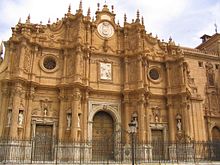Guadix Cathedral
| Guadix Cathedral | |
|---|---|
| Cathedral of the Incarnation, Guadix | |

Façade
|
|
| 37°18′04″N 3°08′11″W / 37.3012°N 3.1363°WCoordinates: 37°18′04″N 3°08′11″W / 37.3012°N 3.1363°W | |
| Location | Guadix |
| Country | Spain |
| Denomination | Roman Catholic |
| Architecture | |
| Status | Cathedral |
| Architect(s) | Diego de Siloé, Francisco Roldán, Francisco Antero, Blas Antonio Delgado, Vicente Acero, Gaspar Cayón de la Vega, Fernández Pachote and Domingo Thomas |
| Style | Baroque |
| Groundbreaking | 16th century |
| Completed | 18th century |
| Administration | |
| Archdiocese | Guadix-Baza |
The Guadix Cathedral, Cathedral of Guadix, or Cathedral of the Incarnation (Spanish: Catedral de la Encarnación de Guadix) is a Roman Catholic cathedral in Guadix, province of Granada, Spain. Construction of the building began in the 16th century and was completed in the mid-18th century. It is in the Baroque style.
Guadix is believed to be one of the oldest diocesan seats in Spain; tradition has it that the diocese was founded by Saint Torquatus of Acci in the first century A.D. The cathedral sits on the site of an earlier Hispano-Visigothic church extant in the 10th century, and which functioned during the Islamic period as a mosque.
During the Reconquista, Guadix was captured by the Christian forces in 1489, and the Hispano-Visigothic church was reestablished as the seat of a bishopric. It was given the name of the Church of Saint Mary of the Incarnation (Iglesia de Santa María de la Encarnación), was made a cathedral by a bull of Pope Innocent VIII, and was somewhat expanded under the direction of Pedro de Morales.
Plans were made to replace the old church with a Gothic cathedral as a symbol of the Reconquista, but by the time construction began, that style was already considered antiquated. Cardinal Ávalos and others wanted a cathedral more in accord with the style of the times. Diego de Siloé was commissioned in 1549 to develop a design reflecting the influence of the cathedrals of Málaga and Granada. The apse, part of the crossing, the chapel of Don Tadeo and parte part of the sacristy were completed according to Siloé's plan.
...
Wikipedia
